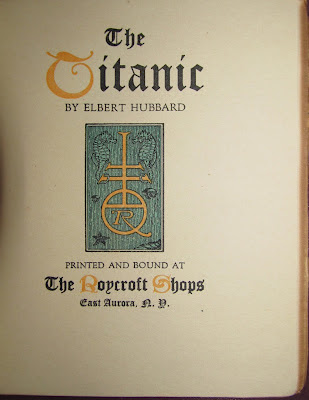The collections department has been busy this week with our new exhibit, Titanic: The Rise of Rosenbach, which opened yesterday. One of the challenges in any exhibition is that there are all sorts of fascinating tidbits that just don’t fit into the story arc and therefore have to (sadly) get left off of the labels. Here are some of my favorite bits from the cutting room floor.
Titanic/Lusitania: Undoubtedly the two most famous ship sinkings of the 20th century were the Titanic, which struck an iceberg in 1912, and the Lusitania, which was torpedoed by a German U-boat in 1915. Strangely enough, as we looked through the Rosenbach material related to the Titanic disaster, we kept finding references to the Lusitania. Philip Rosenbach traveled to England on the Lusitania, London book dealer Bernard Quaritch sent Harry Widener’s posthumous purchases home to America on the Lusitania, fine press publisher Elbert Hubbard wrote a book about the Titanic and then himself went down with the Lusitania when it sank (this did make it into a label). Of course in 1912 there was nothing wrong with the Lusitania and there were only so many ships plying the Atlantic crossing, but we couldn’t help noticing the odd coincidence.

Elbert Hubbard, The Titanic. East Aurora, N. Y.: The Roycroft Shops, 1923. FP.R889 923
St Paul’s: The exhibition focuses on Harry Widener’s book collecting and his mother’s attempt to honor him with a memorial library at Harvard. However, the library wasn’t the only memorial Mrs. Widener created for her family. When I was just beginning the research for this exhibit I met a woman who was a parishioner at St. Paul’s Episcopal Church in Elkins Park. She told me about how Mrs. Widener renovated the church in honor of her husband George and her son, Harry, including donating Tiffany memorial windows. According to Leslie Morris’s article, “Harry Elkins Widener and A.S.W. Rosenbach: Of Books and Friendship,” Dr. Rosenbach, who was quite close with Mrs. Widener in the period after the tragedy, also served as a sounding board for this project, even advising on the selection of altar cloths.
Widener legends: That Harry Widener willed his books to Harvard and that his mother donated a $2 million building to go with them are facts. It is also a fact that his mother stipulated that there could be no significant alterations to the exterior of the building, which has caused Harvard to get creative about expansion and renovations, including in one case running a connecting corridor between Widener and Houghton Libraries through a window. However interesting these facts are, campus legends abound about other supposed Widener rules. Supposedly Harvard instituted mandatory swim tests at the stipulation of Mrs. Widener, who felt that swimming could have saved her son. This is complete nonsense; I have no idea if Harry could swim or not, but it would have been irrelevant to his death, since there was nowhere to swim to. In fact, Harvard’s swim test did not come into force until the 1920s. Another story claims that ice cream is always available in the dining halls because of a Widener requirement. I have no idea how that one got started, but there’s no truth there either. A Snopes article on Widener urban legends points out that similar legends exist at other colleges and that this type of legend is used to explain all kinds of collegiate quirks that have no obvious explanation.
That’s it for this round of the outtake reel. Apropos of last week’s post, I would like to note that I have found several on-line Dickens name generators, including The Dickens Character Generator and the Fictional Character Name Generator. Explore at your own risk.

